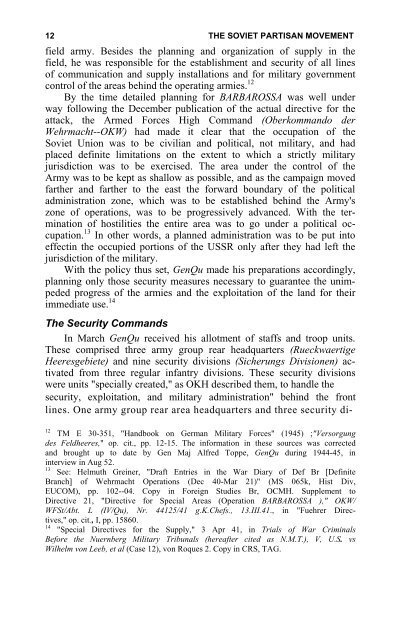the soviet partisan movement 1941-1944 by edgar m. howell
the soviet partisan movement 1941-1944 by edgar m. howell
the soviet partisan movement 1941-1944 by edgar m. howell
You also want an ePaper? Increase the reach of your titles
YUMPU automatically turns print PDFs into web optimized ePapers that Google loves.
12 THE SOVIET PARTISAN MOVEMENT<br />
field army. Besides <strong>the</strong> planning and organization of supply in <strong>the</strong><br />
field, he was responsible for <strong>the</strong> establishment and security of all lines<br />
of communication and supply installations and for military government<br />
control of <strong>the</strong> areas behind <strong>the</strong> operating armies. 12<br />
By <strong>the</strong> time detailed planning for BARBAROSSA was well under<br />
way following <strong>the</strong> December publication of <strong>the</strong> actual directive for <strong>the</strong><br />
attack, <strong>the</strong> Armed Forces High Command (Oberkommando der<br />
Wehrmacht--OKW) had made it clear that <strong>the</strong> occupation of <strong>the</strong><br />
Soviet Union was to be civilian and political, not military, and had<br />
placed definite limitations on <strong>the</strong> extent to which a strictly military<br />
jurisdiction was to be exercised. The area under <strong>the</strong> control of <strong>the</strong><br />
Army was to be kept as shallow as possible, and as <strong>the</strong> campaign moved<br />
far<strong>the</strong>r and far<strong>the</strong>r to <strong>the</strong> east <strong>the</strong> forward boundary of <strong>the</strong> political<br />
administration zone, which was to be established behind <strong>the</strong> Army's<br />
zone of operations, was to be progressively advanced. With <strong>the</strong> termination<br />
of hostilities <strong>the</strong> entire area was to go under a political occupation.<br />
13 In o<strong>the</strong>r words, a planned administration was to be put into<br />
effectin <strong>the</strong> occupied portions of <strong>the</strong> USSR only after <strong>the</strong>y had left <strong>the</strong><br />
jurisdiction of <strong>the</strong> military.<br />
With <strong>the</strong> policy thus set, GenQu made his preparations accordingly,<br />
planning only those security measures necessary to guarantee <strong>the</strong> unimpeded<br />
progress of <strong>the</strong> armies and <strong>the</strong> exploitation of <strong>the</strong> land for <strong>the</strong>ir<br />
immediate use. 14<br />
The Security Commands<br />
In March GenQu received his allotment of staffs and troop units.<br />
These comprised three army group rear headquarters (Rueckwaertige<br />
Heeresgebiete) and nine security divisions (Sicherungs Divisionen) activated<br />
from three regular infantry divisions. These security divisions<br />
were units "specially created," as OKH described <strong>the</strong>m, to handle <strong>the</strong><br />
security, exploitation, and military administration" behind <strong>the</strong> front<br />
lines. One army group rear area headquarters and three security di-<br />
12<br />
TM E 30-351, "Handbook on German Military Forces" (1945) ;"Versorgung<br />
des Feldheeres," op. cit., pp. 12-15. The information in <strong>the</strong>se sources was corrected<br />
and brought up to date <strong>by</strong> Gen Maj Alfred Toppe, GenQu during <strong>1944</strong>-45, in<br />
interview in Aug 52.<br />
13<br />
See: Helmuth Greiner, "Draft Entries in <strong>the</strong> War Diary of Def Br [Definite<br />
Branch] of Wehrmacht Operations (Dec 40-Mar 21)" (MS 065k, Hist Div,<br />
EUCOM), pp. 102--04. Copy in Foreign Studies Br, OCMH. Supplement to<br />
Directive 21, "Directive for Special Areas (Operation BARBAROSSA )," OKW/<br />
WFSt/Abt. L (IV/Qu), Nr. 44125/41 g.K.Chefs., 13.III.41., in "Fuehrer Directives,"<br />
op. cit., I, pp. 15860.<br />
14<br />
"Special Directives for <strong>the</strong> Supply," 3 Apr 41, in Trials of War Criminals<br />
Before <strong>the</strong> Nuernberg Military Tribunals (hereafter cited as N.M.T.), V, U.S. vs<br />
Wilhelm von Leeb, et al (Case 12), von Roques 2. Copy in CRS, TAG.
















